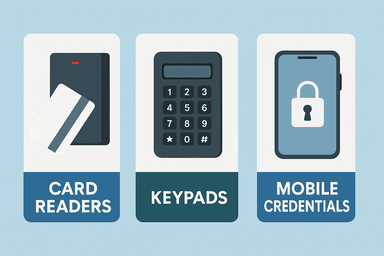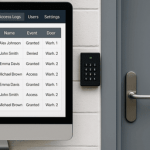
If you’ve ever wondered which type of access control system is best for your building—card reader, keypad, or mobile credential—you’re not alone.
At Southeastern Security Professionals (SSP), we get this question all the time from business owners, school administrators, and facility managers looking to upgrade their entry systems. And the truth is, there’s no one-size-fits-all solution.
In this post, we’re breaking down the three most common types of access control systems—how they work, their pros and cons, and how to choose the right one for your environment.
k
k
🔐 What Is Access Control, Anyway?
Before we dive into the options, let’s define it.
Access control is a system that determines who can enter a building, room, or secure area—and when they’re allowed to do so. Modern systems go far beyond traditional locks and keys, giving you:
-
Detailed access logs
-
Permission scheduling
-
Remote access capabilities
-
Integration with cameras, alarms, and intercoms
The goal? Convenience + accountability + security.
k
k
🔍 Option 1: Card Readers
✅ How They Work:
Users present a keycard or badge (typically RFID-enabled) to a reader at the door. If the card is authorized, the door unlocks.
👍 Pros:
-
Fast and easy to use
-
Affordable for medium to large teams
-
Can include photo ID or branding
-
Easy to assign/revoke access permissions
👎 Cons:
-
Cards can be lost or stolen
-
Cards may be shared between users
-
Requires replacing cards over time
💡 Best For:
Schools, office buildings, warehouses, or anywhere with moderate to high foot traffic.
k
k
🔢 Option 2: Keypads
✅ How They Work:
Users enter a numeric PIN code to unlock the door. Some systems allow temporary codes or rotating PINs for added security.
👍 Pros:
-
No physical cards to issue or replace
-
Easy for small teams or low-traffic doors
-
Temporary codes are great for deliveries or guests
-
Affordable and straightforward
👎 Cons:
-
PINs can be shared or guessed
-
No user-specific logging unless paired with a secondary method
-
Doesn’t offer dual-factor security unless integrated
💡 Best For:
Back entrances, utility closets, storage rooms, or small offices with limited users.
k
k
📱 Option 3: Mobile Credentials
✅ How They Work:
Users gain access through an app or digital key on their smartphone. Bluetooth, Wi-Fi, or NFC technology allows them to “tap” or “swipe” to unlock.
👍 Pros:
-
No cards or PINs to manage
-
Credentials are tied to unique devices
-
High-level encryption = stronger security
-
Integrates easily with cloud platforms
👎 Cons:
-
Requires smartphones (not ideal for all users)
-
Dependent on app functionality and updates
-
Slightly higher setup cost
💡 Best For:
Tech-savvy offices, hybrid workspaces, commercial buildings, and clients who want cloud-connected access control with real-time data.
k
k
🧠 So, Which One Is Right for You?
Choosing the best access control method depends on a few key factors:
-
How many users will need access?
-
How secure does the area need to be?
-
Do you need remote access or real-time logs?
-
Will users have smartphones, cards, or prefer simple PINs?
Often, the best solution is a hybrid system—for example, mobile credentials at the front door, keypads for interior spaces, and card readers for visitors or part-time staff.
k
k
🔄 Access Control Is Flexible—And So Are We
At SSP, we help you design an access control solution that fits your building, your people, and your day-to-day operations. Whether you're a school locking down during the day, a warehouse tracking staff entries, or a church managing volunteers—we build systems that make access simple, secure, and scalable.
Ready to upgrade your entry points?
Contact us today for a custom access control consultation.


